Tiếng Anh chuyên ngành Trắc địa
1.1. SURVEYING: TRẮC ĐỊA
1. Từ mới:
• Define: [di’fain]: v: định nghĩa.
• Measurement: ['məʒəmənt]: n: sự đo lường, phép đo
• Relative: ['relətiv]: adj: liên quan đến, tương đối
• Position: [pə'zi∫n]: n: vị trí; lập trường, quan điểm
• Man made: do con người tạo ra, nhân tạo.
• Feature: ['fi:t∫ə]: n: điểm đặc trưng
• Surface: ['sə:fis]: n: bề mặt
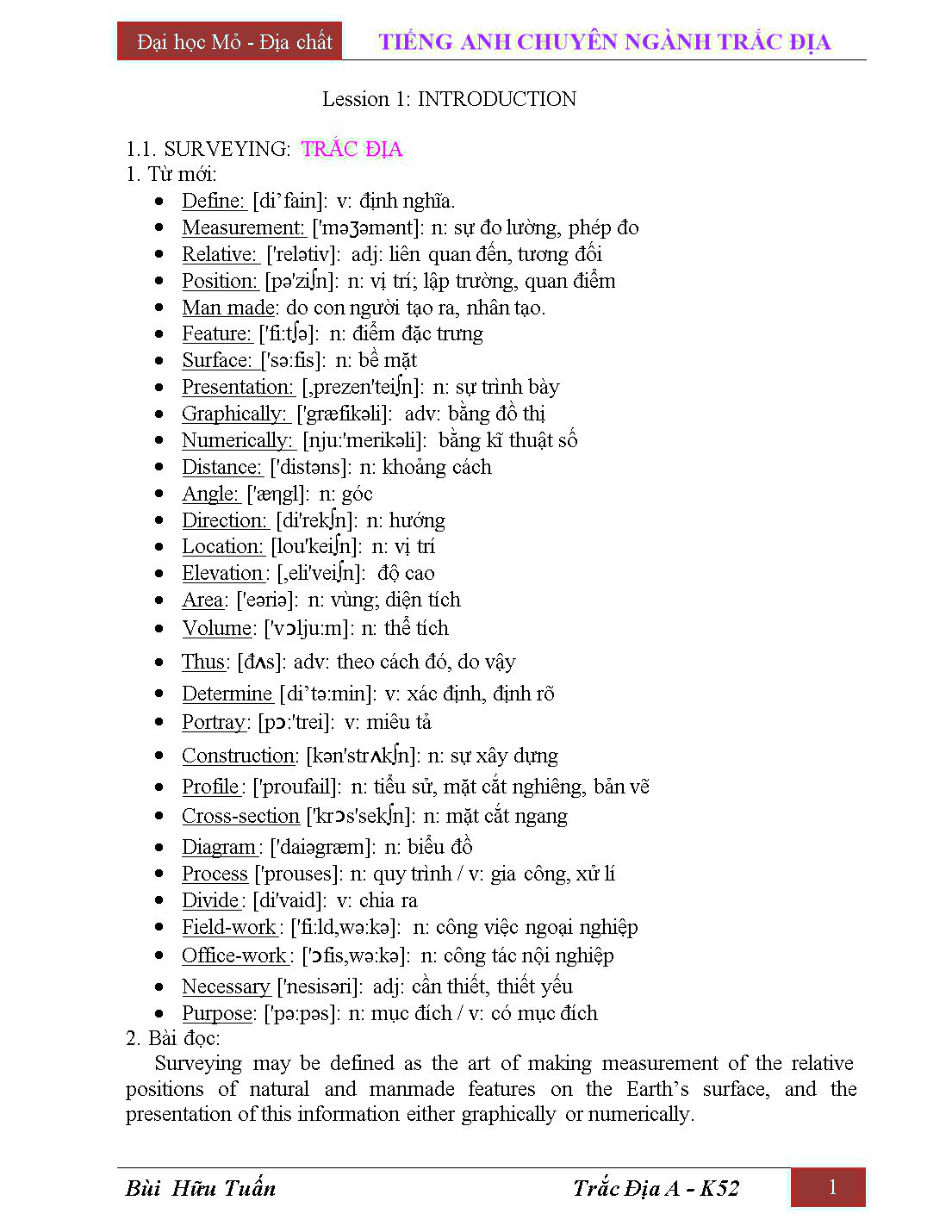
Trang 1
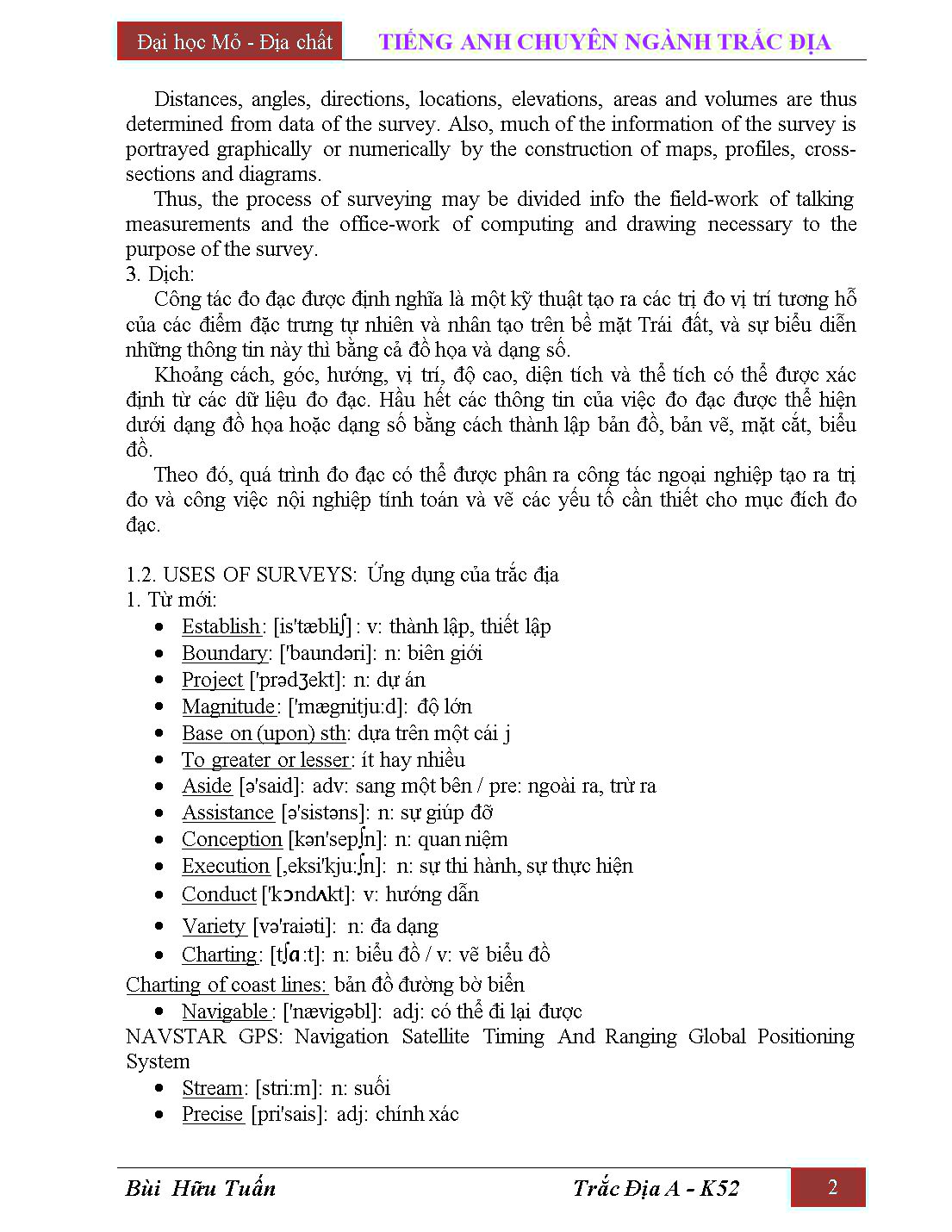
Trang 2
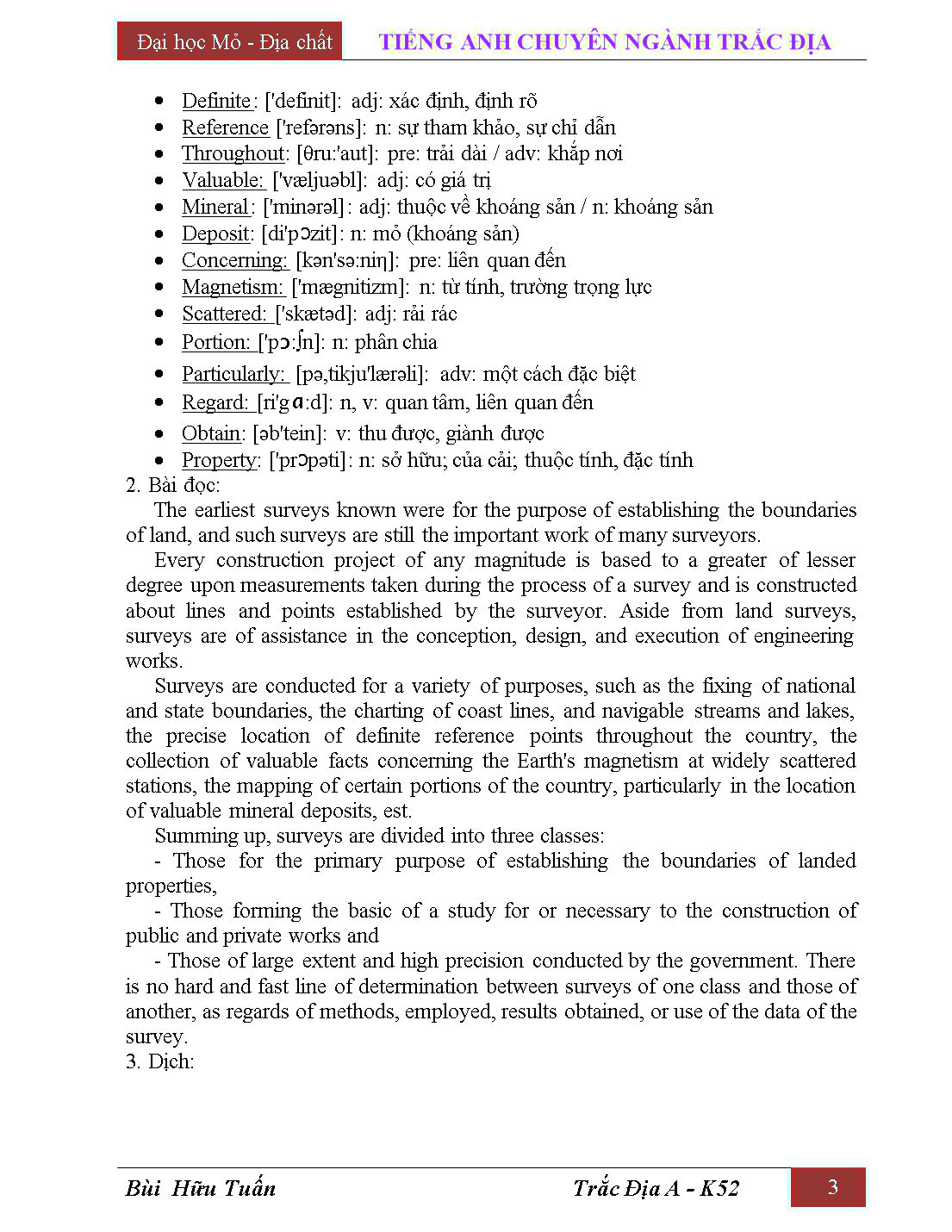
Trang 3
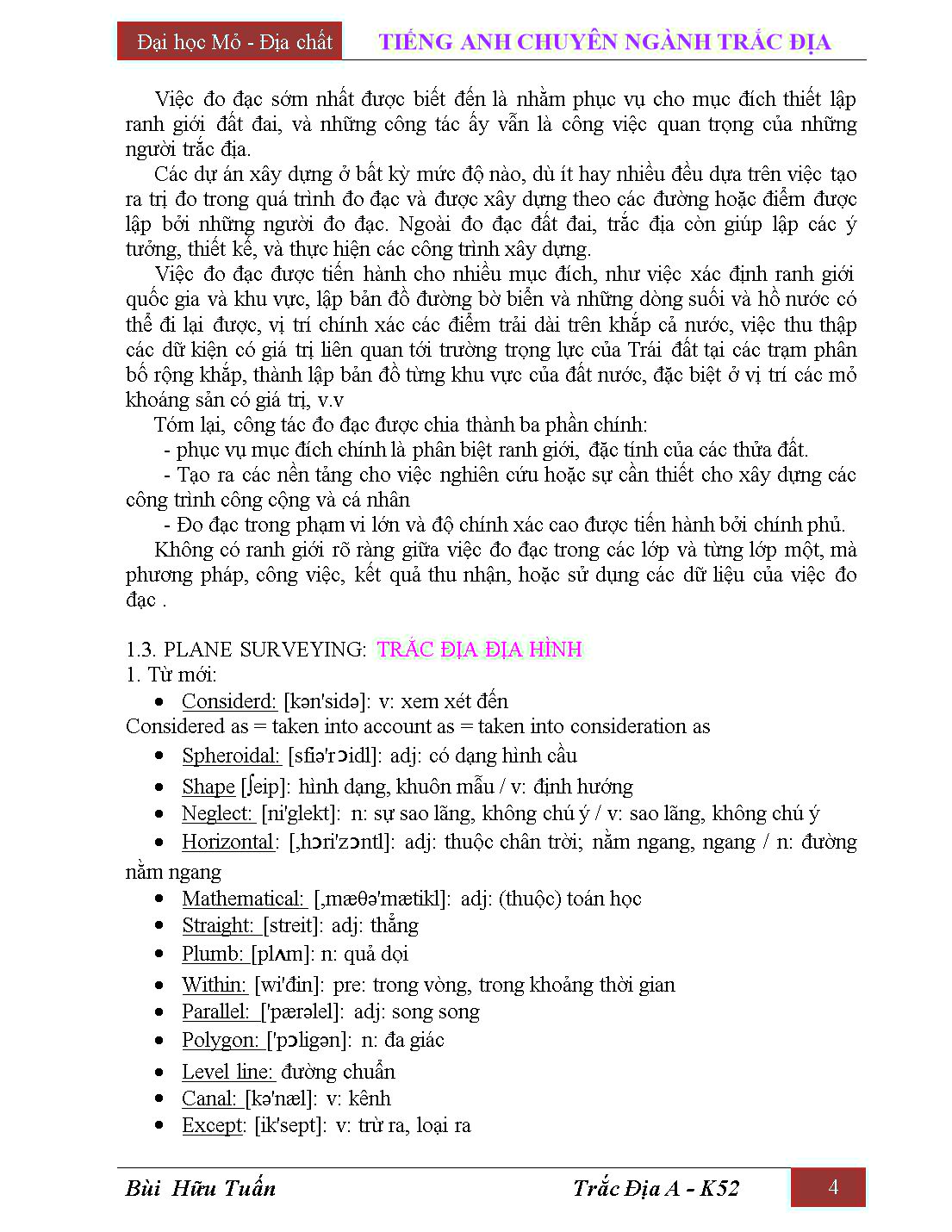
Trang 4
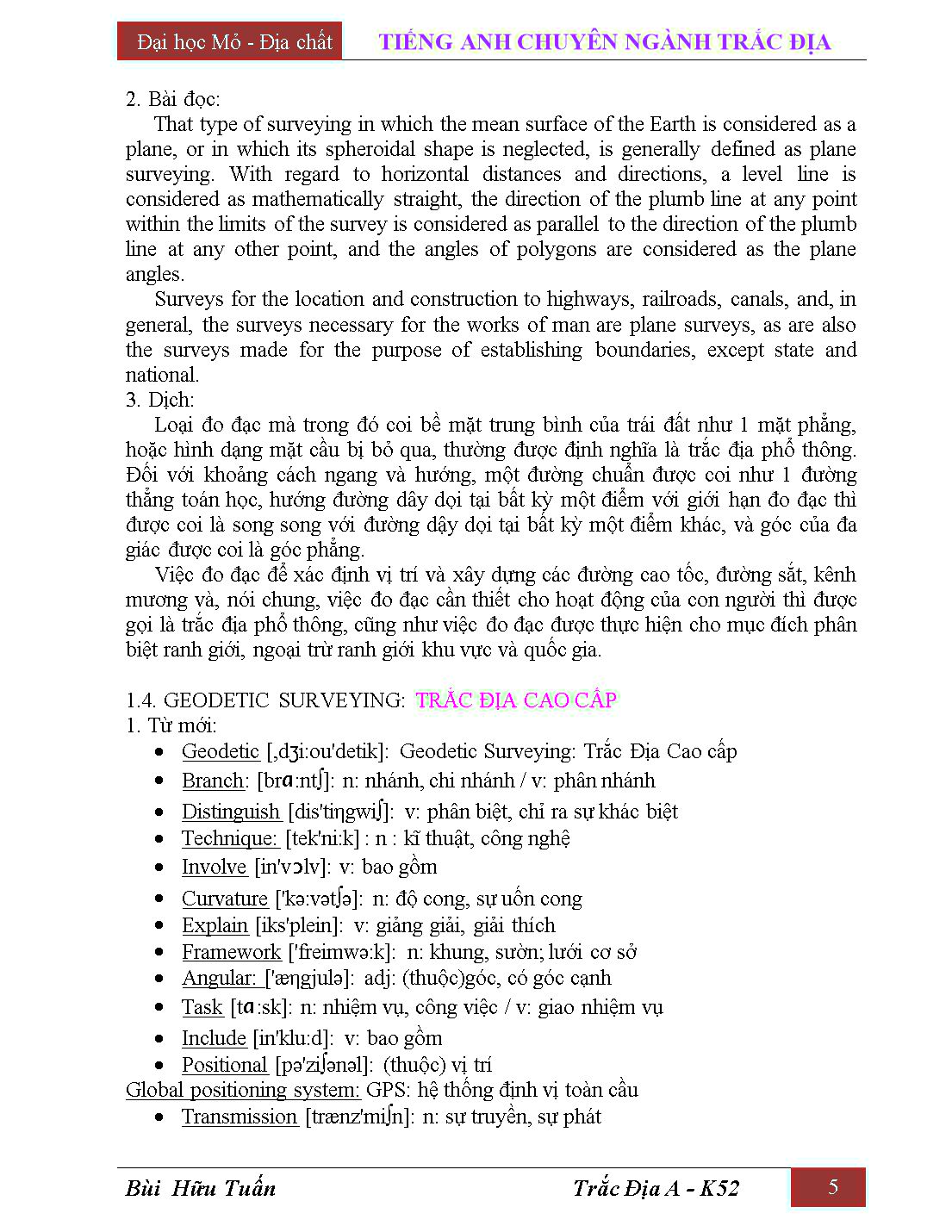
Trang 5
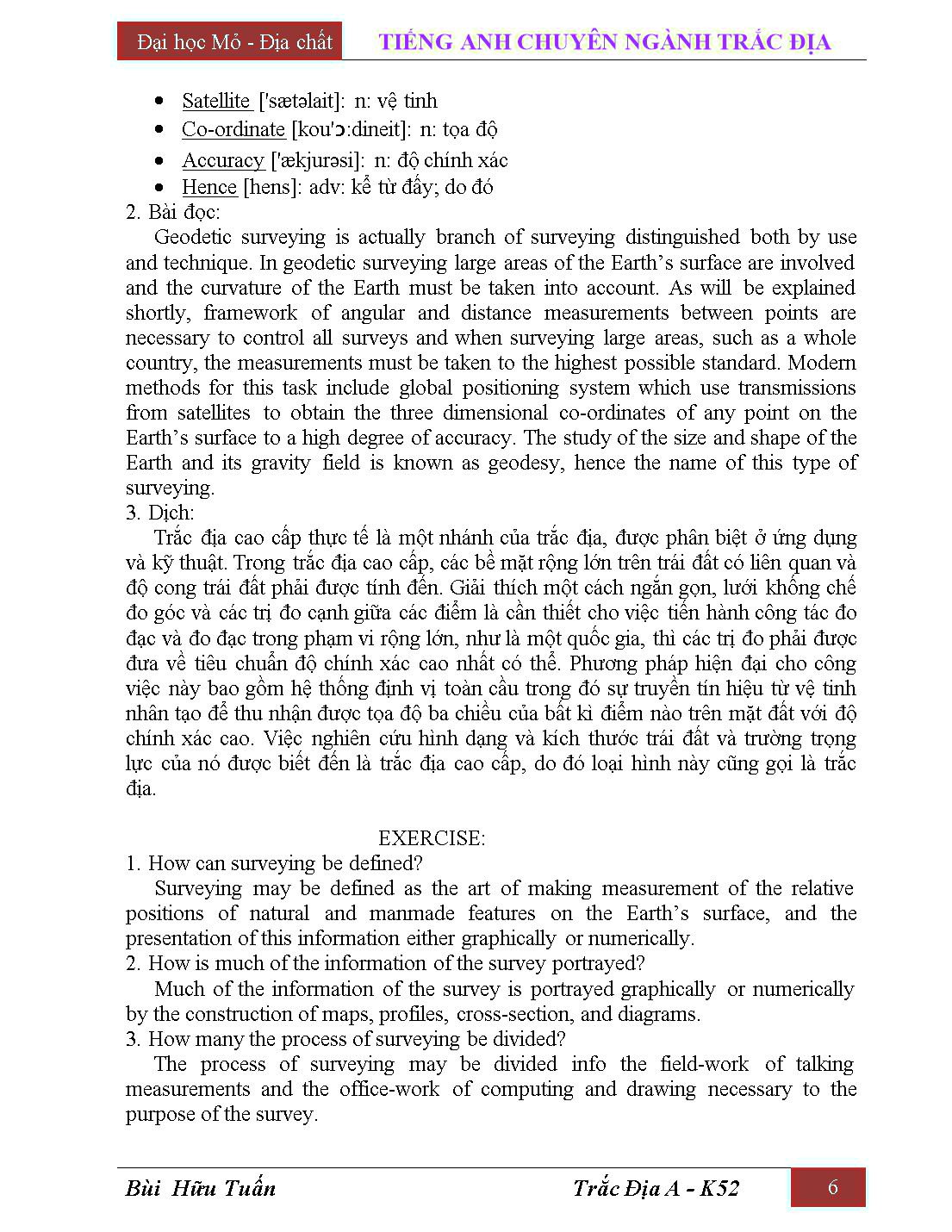
Trang 6
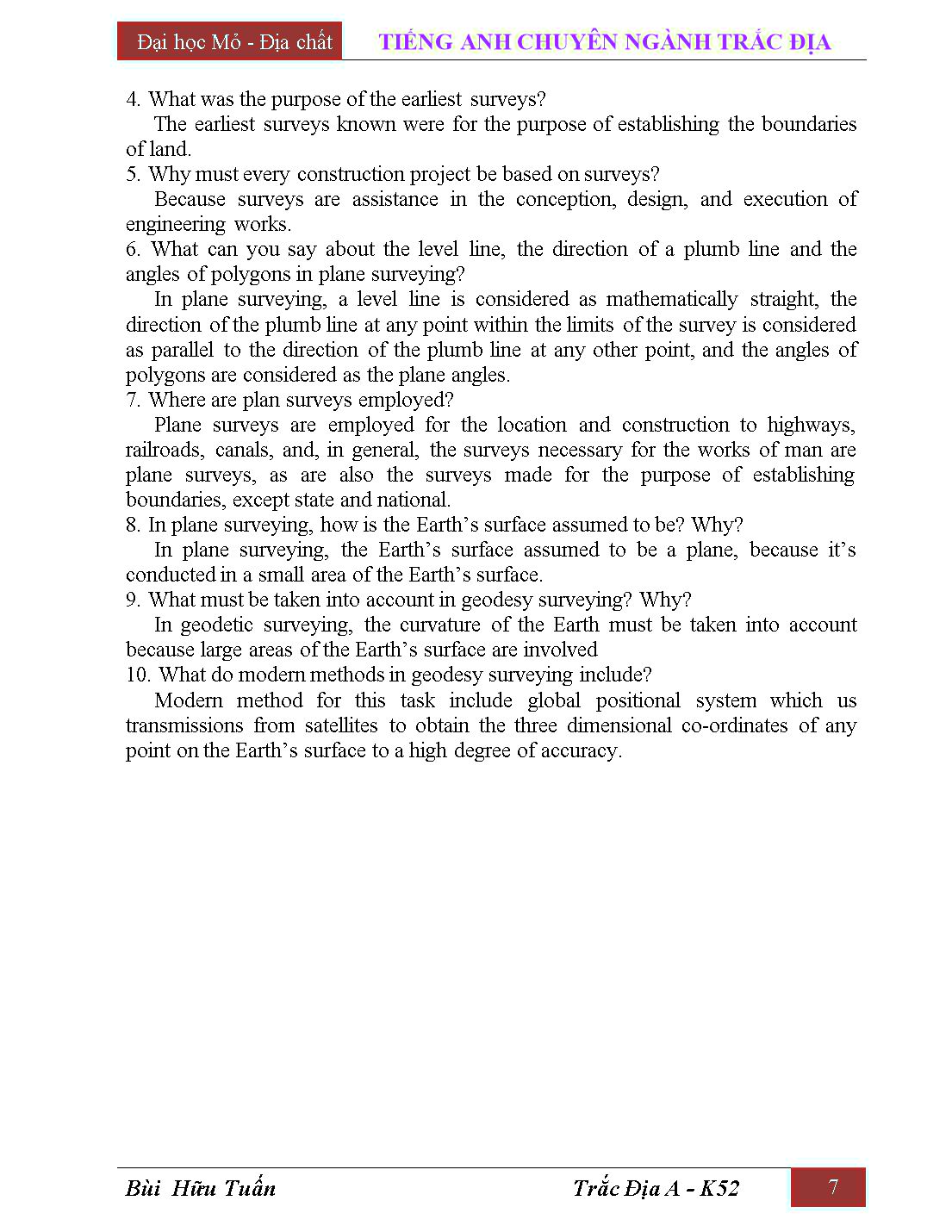
Trang 7
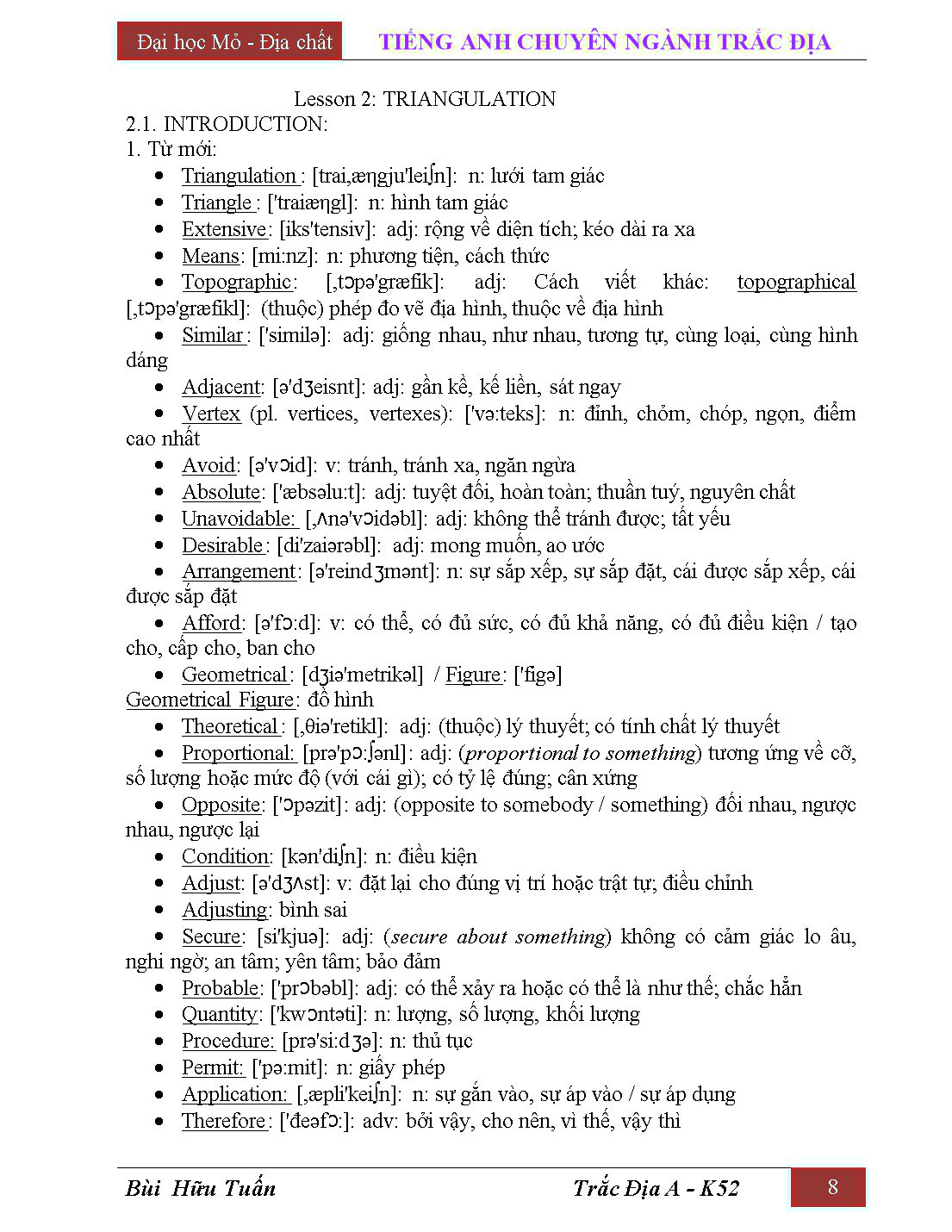
Trang 8
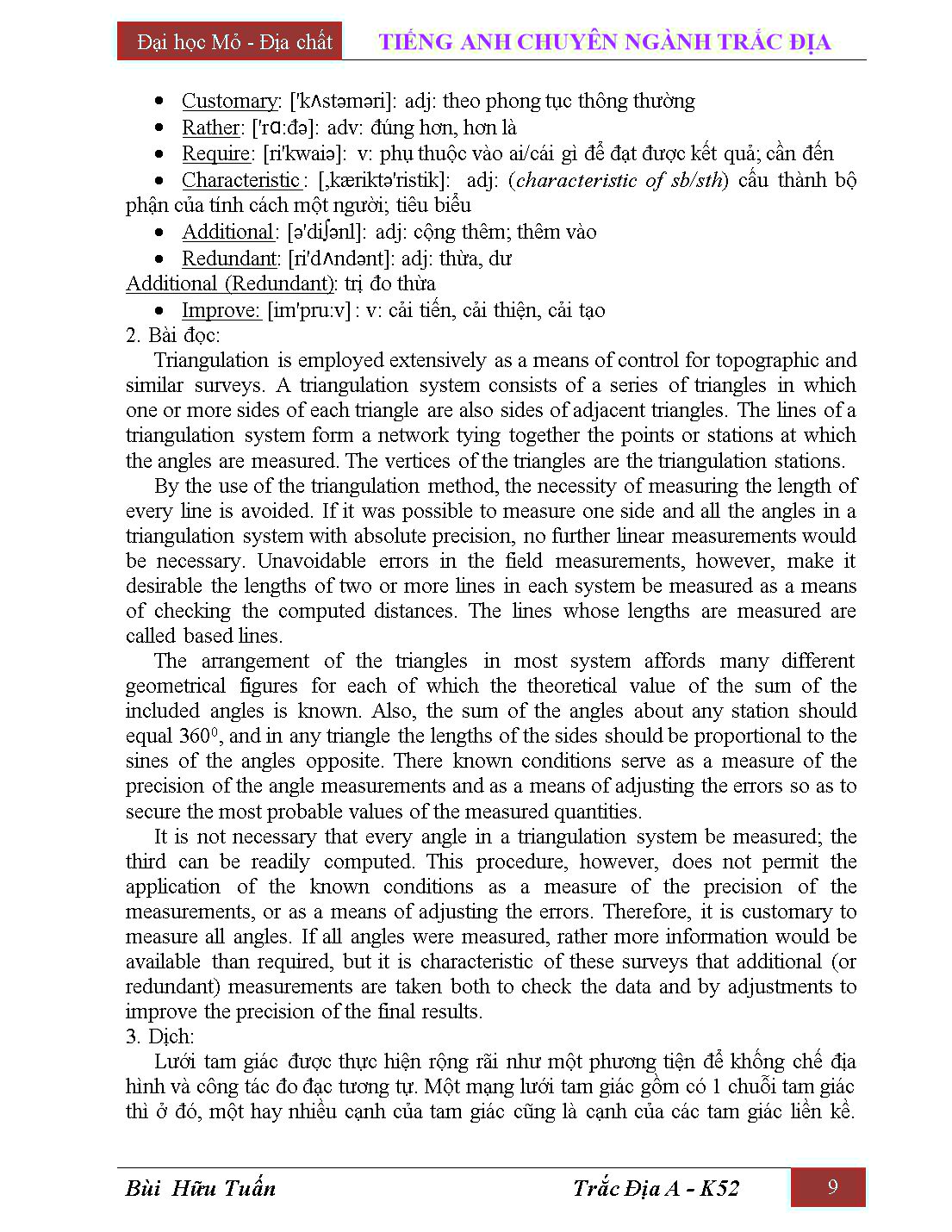
Trang 9
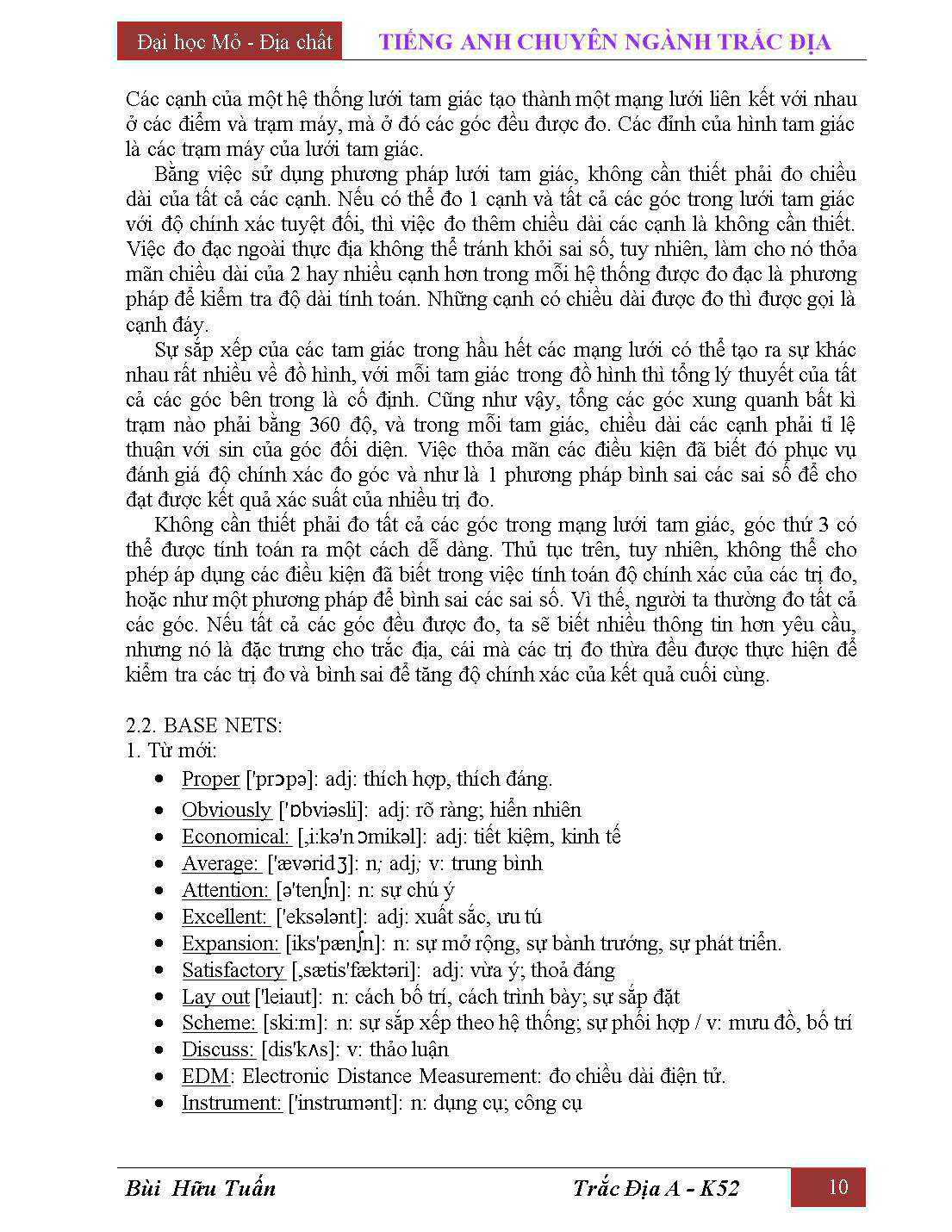
Trang 10
Tải về để xem bản đầy đủ
Bạn đang xem 10 trang mẫu của tài liệu "Tiếng Anh chuyên ngành Trắc địa", để tải tài liệu gốc về máy hãy click vào nút Download ở trên
Tóm tắt nội dung tài liệu: Tiếng Anh chuyên ngành Trắc địa
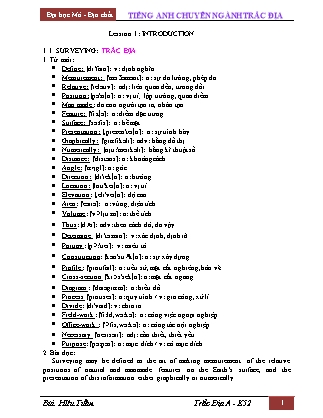
Lession 1: INTRODUCTION 1.1. SURVEYING: TRẮC ĐỊA 1. Từ mới: Define: [di’fain]: v: định nghĩa. Measurement: ['məʒəmənt]: n: sự đo lường, phép đo Relative: ['relətiv]: adj: liên quan đến, tương đối Position: [pə'zi∫n]: n: vị trí; lập trường, quan điểm Man made: do con người tạo ra, nhân tạo. Feature: ['fi:t∫ə]: n: điểm đặc trưng Surface: ['sə:fis]: n: bề mặt Presentation: [,prezen'tei∫n]: n: sự trình bày Graphically: ['græfikəli]: adv: bằng đồ thị Numerically: [nju:'merikəli]: bằng kĩ thuật số Distance: ['distəns]: n: khoảng cách Angle: ['æηgl]: n: góc Direction: [di'rek∫n]: n: hướng Location: [lou'kei∫n]: n: vị trí Elevation: [,eli'vei∫n]: độ cao Area: ['eəriə]: n: vùng; diện tích Volume: ['vɔlju:m]: n: thể tích Thus: [đʌs]: adv: theo cách đó, do vậy Determine [di’tә:min]: v: xác định, định rõ Portray: [pɔ:'trei]: v: miêu tả Construction: [kən'strʌk∫n]: n: sự xây dựng Profile: ['proufail]: n: tiểu sử, mặt cắt nghiêng, bản vẽ Cross-section ['krɔs'sek∫n]: n: mặt cắt ngang Diagram: ['daiəgræm]: n: biểu đồ Process ['prouses]: n: quy trình / v: gia công, xử lí Divide: [di'vaid]: v: chia ra Field-work: ['fi:ld,wə:kə]: n: công việc ngoại nghiệp Office-work: ['ɔfis,wə:kə]: n: công tác nội nghiệp Necessary ['nesisəri]: adj: cần thiết, thiết yếu Purpose: ['pə:pəs]: n: mục đích / v: có mục đích 2. Bài đọc: Surveying may be defined as the art of making measurement of the relative positions of natural and manmade features on the Earth’s surface, and the presentation of this information either graphically or numerically. Distances, angles, directions, locations, elevations, areas and volumes are thus determined from data of the survey. Also, much of the information of the survey is portrayed graphically or numerically by the construction of maps, profiles, cross-sections and diagrams. Thus, the process of surveying may be divided info the field-work of talking measurements and the office-work of computing and drawing necessary to the purpose of the survey. 3. Dịch: Công tác đo đạc được định nghĩa là một kỹ thuật tạo ra các trị đo vị trí tương hỗ của các điểm đặc trưng tự nhiên và nhân tạo trên bề mặt Trái đất, và sự biểu diễn những thông tin này thì bằng cả đồ họa và dạng số. Khoảng cách, góc, hướng, vị trí, độ cao, diện tích và thể tích có thể được xác định từ các dữ liệu đo đạc. Hầu hết các thông tin của việc đo đạc được thể hiện dưới dạng đồ họa hoặc dạng số bằng cách thành lập bản đồ, bản vẽ, mặt cắt, biểu đồ. Theo đó, quá trình đo đạc có thể được phân ra công tác ngoại nghiệp tạo ra trị đo và công việc nội nghiệp tính toán và vẽ các yếu tố cần thiết cho mục đích đo đạc. 1.2. USES OF SURVEYS: Ứng dụng của trắc địa 1. Từ mới: Establish: [is'tæbli∫]: v: thành lập, thiết lập Boundary: ['baundəri]: n: biên giới Project ['prədʒekt]: n: dự án Magnitude: ['mægnitju:d]: độ lớn Base on (upon) sth: dựa trên một cái j To greater or lesser: ít hay nhiều Aside [ə'said]: adv: sang một bên / pre: ngoài ra, trừ ra Assistance [ə'sistəns]: n: sự giúp đỡ Conception [kən'sep∫n]: n: quan niệm Execution [,eksi'kju:∫n]: n: sự thi hành, sự thực hiện Conduct ['kɔndʌkt]: v: hướng dẫn Variety [və'raiəti]: n: đa dạng Charting: [t∫ɑ:t]: n: biểu đồ / v: vẽ biểu đồ Charting of coast lines: bản đồ đường bờ biển Navigable: ['nævigəbl]: adj: có thể đi lại được NAVSTAR GPS: Navigation Satellite Timing And Ranging Global Positioning System Stream: [stri:m]: n: suối Precise [pri'sais]: adj: chính xác Definite: ['definit]: adj: xác định, định rõ Reference ['refərəns]: n: sự tham khảo, sự chỉ dẫn Throughout: [θru:'aut]: pre: trải dài / adv: khắp nơi Valuable: ['væljuəbl]: adj: có giá trị Mineral: ['minərəl]: adj: thuộc về khoáng sản / n: khoáng sản Deposit: [di'pɔzit]: n: mỏ (khoáng sản) Concerning: [kən'sə:niη]: pre: liên quan đến Magnetism: ['mægnitizm]: n: từ tính, trường trọng lực Scattered: ['skætəd]: adj: rải rác Portion: ['pɔ:∫n]: n: phân chia Particularly: [pə,tikju'lærəli]: adv: một cách đặc biệt Regard: [ri'gɑ:d]: n, v: quan tâm, liên quan đến Obtain: [əb'tein]: v: thu được, giành được Property: ['prɔpəti]: n: sở hữu; của cải; thuộc tính, đặc tính 2. Bài đọc: The earliest surveys known were for the purpose of establishing the boundaries of land, and such surveys are still the important work of many surveyors. Every construction project of any magnitude is based to a greater of lesser degree upon measurements taken during the process of a survey and is constructed about lines and points established by the surveyor. Aside from land surveys, surveys are of assistance in the conception, design, and execution of engineering works. Surveys are conducted for a variety of purposes, such as the fixing of national and state boundaries, the charting of coast lines, and navigable streams and lakes, the precise location of definite reference points throughout the country, the collection of valuable facts concerning the Earth's magnetism at widely scattered stations, the mapping of certain portions of the country, particularly in the location of valuable mineral deposits, est. Summing up, surveys are divided into three classes: - Those for the primary purpose of establishing the boundaries of landed properties, - Those forming the basic of a study for or necessary to the construction of public and private works and - Those of large extent and high precision conducted by the government. There is no hard and fast line of determination between surveys of one class and those of another, as regards of methods, employed, results obtained, or use of the data of the survey. 3. Dịch: Việc đo đạc sớm nhất được biết đến là nhằm phục vụ cho mục đích thiết lập ranh giới đất đai, và những công tác ấy vẫn là công việc quan trọng của những người trắc địa. Các dự án xây dựng ở bất kỳ mức độ nào, dù ít hay nhiều đều dựa trên việc tạo ra trị đo trong quá trình đo đạc và được xây dựng theo các đường hoặc điểm được lập bởi những người đo đạc. Ngoài đo đạc đất đai, trắ ... thu được thiết lập đồng thời ở trạm tham chiếu và thiết bị chuyển động. Có 2 phương thức đo GPS vi phân: - Đo thời gian thực bởi phương tiện truyền số hiệu chỉnh từ trạm tham chiếu tới máy thu động để thu được vị trí tức thời chính xác của thiết bị chuyển động. - Kết hợp xử lí sau, sử dụng số liệu đo GPS của các trị đo đồng thời từ trạm tham chiếu và máy thu động để xử lí dữ liệu trong phòng. EXERCISE 1. Which segment does the GPS system consist of? The GPS system consists of three major segments: the space segment, the control segment, and the user segment. 2. State constellation and functions of the space segment? The space segment includes 24 satellites arrayed in 6 orbit planes incline 55 degrees to the equator. Each orbit is at the altitude of 20,200km. Each satellite transmits 2 frequency signals for navigation and positioning. 3. State structure and operations of the control segment? The control segment includes a master control station (MCS) at the consolidated Space Operation Center at Colorado Spring, and a number of monitor stations, located throughout the world, such as the stations on Diego Garcia, Ascension Island, Kwajalein and Hawaii. The control segment monitors the health of GPS satellites, determine their orbits and behavior of their atomic clocks, and inject the broadcast message into GPS satellites. 4. Mention some applications of GPS receivers? The user segment includes static and kinematic receivers. The static receivers are used to determine fixed point positions where receiver antennas do not move in respect to the Earth. The kinematic receivers are used to determine motional carrier positions and velocities, even attitude parameters, that is, GPS kinematic measurements imply that receiver antennas are motional in spect to the Earth. 5. Describe the GPS static positioning method? The GPS static positioning method is used to determine the position of stationary (fixed) points with respect to the Earth which bases on simultaneously survey ranges from satellites to receiver antennas. 6. Describe the GPS kinematic positioning method? 7.4 7. Is there any difference between static and kinematic positioning? Yes. The differences between static and kinematic positioning are: - Different motional carrier. - Different navigation speed. - Different accuracy requirement. 8. What’s DGPS? Lesson 8: MAP PLOTTING 1. Từ mới: Irrigation: [,iri'gei∫n]: n: sự tưới (đất, ruộng) Drainage: ['dreinidʒ]: n: sự tiêu nước Hydrographic: [,haidrou'græfik]: n: thủy văn học Rural: ['ruərəl]: adj: nông thôn 2. Bài đọc: The methods of plotting described in this chapter are those employed in mapping areas limited extent where the Earth’s surface is assumed to be plane and all meridians are assumed to be parallel. These methods are applicable to surveys for highways, railroad, and irrigation and drainage system; to many topographic and hydrographic surveys; and to rural and urban land system. 3. Dịch: Phương pháp vẽ bản đồ được miêu tả trong chương này được tiến hành trong khu vực đo vẽ giới hạn, nơi bề mặt Trái đất được coi là phẳng và các kinh tuyến được xem là song song. Phương pháp này được áp dụng để đo đạc đường cao tốc, đường sắt và hệ thống tưới tiêu trong đo đạc địa hình và thủy văn, và để đo đạc khu vực đô thị và nông thôn. 8.1. PROCESS OF MAKING MAP: 1. Từ mới: Furnish: ['fə:ni∫]: v: cung cấp Sense: [sens]: n: hướng, chiều Reverse: [ri'və:s]: adj: ngược, đảo ngược Compilation: [,kɔmpi'lei∫n]: n: sự biên soạn Coordinatograph: máy chuyển tọa độ Expeditiously: [,ekspi'di∫əsli]: adv: một cách nhanh chóng Expedite: ['ekspidait]: v: tiến hành, giải quyết Stereoscopic: [,steriəs'kɔpik]: adj: nổi, lập thể Principally: ['prinsəpəli]: adv: phần lớn, chủ yếu Visual: ['vi∫uəl]: adj: sự nhìn, (thuộc) thị giác Reconstruction: [,ri:kən'strʌk∫n]: n: sự dựng lại, sự tái thiết Analysis: [ə'næləsis]: n, pl. analyses: sự phân tích; phép phân tích Aerial: ['eəriəl]: adj: trên không Complex: ['kɔmpleks]: adj: phức tạp Terrestrial: [tə'restriəl]: adj: trên cạn, trên mặt đất 2. Bài đọc: Regardless of their purpose of kind, maps are usually so plotted features are shown in the same relative location that they occupy on the ground, at a given scale. Hence the data of a survey furnish the information that is necessary to plot the map, and the operations of plotting are in a sense the reverse of the operations of surveying. In general, the process of mapping involves the plotting, by more precise method, of points of horizontal control which are generally transmit stations and which may be traverse points, triangulation points, or both, and the plotting, by less precise methods of features to these details being given in the form of angles and distances from the lines and points in the horizontal control system. The map complilation is made on a table called coordinatograph. Most maps are plotted wholly in the office from data taken in the fields, but where conditions are favourable and the objects to be shown are numerous, maps are often plotted more expeditiously in the field as the survey progresses. As a general rule, the points of primary horizontal control are plotted in the office, but often when details are mapped in the field, points of secondary horizontal control are fixed on the ground only as it becomes necessary to establish such points to expedite the location of details. Today, maps may be also made from photographs owing to the advances made in the application of stereoscopic photography (two pictures of the same area from different viewpoints), principally in vertical photographs taken from an aircraft. This method permits the visual reconstruction of a three-dimensional image of the area viewed. The production of accurate maps from the stereoscopic study and analysis of air photographs is the province of a photogrammetric specialist. Aerial survey and mapping requires the use of very large complex and expensive plotting machines (e.g Autograph – a precision plotter for aerial and terrestrial photographs at all scale), but air survey provides the only possible means of mapping large developed areas of the world. 3. Dịch: Quá trình thành lập bản đồ: Bất kể với mục đích nào đi nữa, bản đồ thường để vẽ các đặc trưng được thể hiện ở mối tương quan vị trí điểm trên mặt đất, với một tỉ lệ nhất định. Do đó, các dữ liệu đo đạc cung cấp thông tin cần thiết để đo vẽ bản đồ, và công việc đo vẽ diễn ra theo chiều hướng ngược lại với quá trình đo đạc. Thông thường, quá trình thành lập bản đồ bao gồm việc đo vẽ, với các phương pháp chính xác hơn, các điểm khống chế mặt bằng, cái mà thường được truyền từ các trạm và có thể là điểm đường chuyền, lưới tam giác, hoặc cả hai, và việc đo vẽ, với độ chính xác thấp hơn, các điểm chi tiết đặc trưng được đưa ra từ các góc, khoảng cách từ các cạnh và điểm của lưới khống chế mặt bằng. Việc biên tập bản đồ được thực hiện trên một bàn được gọi là máy chuyển tọa độ. Phần lớn bản đồ được vẽ toàn bộ trong phòng từ các dữ liệu đo đạc ngoài thực địa, nhưng ở những nơi có điều kiện thuận lợi và đối tượng được thể hiện nhiều, bản đồ thường được vẽ nhanh hơn ở những khu vực tiến hành đo đạc. Nguyên tắc chung, các điểm khống chế mặt bằng cấp I được vẽ ở trong phòng, nhưng thường các chi tiết được vẽ ngoài thực địa, các điểm khống chế mặt bằng cấp II được đánh dấu trên mặt đất chỉ khi nó trở nên cần thiết để thành lập vị trí các điểm chi tiết. Ngày nay, bản đồ cũng có thể được thành lập từ các ảnh do những tiến bộ trong việc ứng dụng của phương pháp đo ảnh lập thể (hai ảnh chụp cùng một vùng với hai tâm chụp khác nhau), phần lớn là ảnh thẳng đứng được chụp từ máy bay. Phương pháp này cho phép dựng lại ảnh không gian ba chiều của khu vực chụp. Sản phẩm của bản đồ chính xác từ sự nghiên cứu và phân tích lập thể của ảnh hàng không là lĩnh vực của các chuyên gia ảnh. Đo đạc trên không và thành lập bản đồ yêu cầu việc sử dụng các thiết bị đo vẽ rất phức tạp và đắt tiền (như Autograph – một máy đo vẽ chính xác phục vụ cho đo ảnh trên không và trên mặt đất ở tất cả các tỷ lệ), nhưng đo đạc trên không chỉ có thể đo vẽ các vùng rộng lớn trên thế giới. 8.2. N OTES AND LEGENDS: 1. Từ mới: Explanatory: [iks'plænətəri]: adj: có tính giải thích, có tính thanh minh Interpret: [in'tə:prit]: v: giải thích, làm sang tỏ; dịch Brief: [bri:f]: adj: ngắn gọn, vắn tắt; n: bản tóm tắt; v: tóm tắt lại Circumstance: ['sə:kəmstəns]: n: trường hợp, hoàn cảnh, tình huống; chi tiết; nghi lễ Conventional: [kən'ven∫ənl]: adj: quy ước, thông thường Partly: ['pɑ:tli]: adv: phần nào Astronomical: [,æstrə'nɔmikəl]: adj: thiên văn, vô cùng to lớn Indicate: ['indikeit]: v: trình bày sơ qua, tỏ ra, ngụ ý, biểu thị 2. Bài đọc: Explanatory notes or legends are often of assistance in interpreting a drawing. They should be as brief as circumstances will follow, but at the same time should include sufficient information as to leave no doubt in the mind of the person using the drawing. A key to the symbols representing various details ought to be shown unless the symbols are conventional in character: the nature and sources of data upon which the drawing is based ought sometime to be made known. For example, the data for a map may be obtained from several sources, perhaps partly from old maps partly from old survey notes, and partly from new surveys; the meridian has been determined by astronomical observation; and elevations are referred to a certain datum as indicated by a certain bench mark of a previous survey. 3. Dịch: Chú thích và chú giải Chú thích và chú giải thường giúp đỡ trong việc thể hiện một bản vẽ. Chúng nên vắn tắt ở mức độ chi tiết cho phép, nhưng ở cùng một thời điểm bao gồm đủ thông tin để tránh sự nhầm lẫn với người sử dụng bản vẽ. Một biểu tượng trình bày lại các điểm chi tiết một cách đa dạng phải được thể hiện bằng kí hiệu, thông thường là bằng các chữ cái: thông tin tự nhiên và nguồn gốc của các thông tin, cái mà bản vẽ dựa vào, đôi lúc phải được biết. Ví dụ, thông tin của một bản đồ có thể được sử dụng từ một vài nguồn, có thể một phần từ các bản đồ cũ, một phần từ các chú thích trắc địa cũ, và một phần từ việc đo vẽ mới; kinh tuyến được xác định bởi các trị đo thiên văn; và độ cao được chuyển từ một mặt thủy chuẩn nào đó được biểu thị bởi một điểm gốc của việc đo đạc trước đó. 8.3. CONVENTIONAL SIGNS: 1. Bài đọc: Objects are represented on a map by signs or symbols, many of which are conventional. Some of these are shown in fig 8.1. 2. Dịch: Các đối tượng thường được thể hiện trên bản đồ bằng kí hiệu hay biểu tượng, rất nhiều trong số chúng là quy ước. Một vài ví dụ được thể hiện như ở hình 8.1. Đường điện Nhà cao tầng Nhà thờ Sông Điểm của lưới tam giác EXERCISE: 1. Where are the methods of plotting described in this chapter employed? The methods of plotting described in this chapter are those employed in mapping areas limited extent where the Earth’s surface is assumed to be plane and all meridians are assumed to be parallel. 2. What is assumed in these methods? In these methods, the Earth’s surface is assumed to be plane and all meridians are assumed to be parallel. 3. Where are these methods applicable? These methods are applicable to surveys for highways, railroad, and irrigation and drainage system; to many topographic and hydrographic surveys; and to rural and urban land system. 4. How are maps usually plotted? Maps are usually so plotted features are shown in the same relative location that they occupy on the ground, at a given scale. 5. What is the information necessary to plot a map furnished by? The data of a survey furnish the information that is necessary to plot the map. 6. What does the process of mapping involve? The process of mapping involves the plotting, by more precise method, of points of horizontal control which are generally transmit stations and which may be traverse points, triangulation points, or both, and the plotting, by less precise methods of features to these details being given in the form of angles and distances from the lines and points in the horizontal control system. 7. Where are most map plotted? Most maps are plotted wholly in the office from data taken in the fields. 8. Is this practice always followed? No. Where conditions are favourable and the objects to be shown are numerous, maps are often plotted more expeditiously in the field as the survey progresses. 9. How may maps be made today? Maps may be also made from photographs owing to the advances made in the application of stereoscopic photography (two pictures of the same area from different viewpoints), principally in vertical photographs taken from an aircraft. 10. What does the application of stereoscopic photography permit? This method permits the visual reconstruction of a three-dimensional image of the area viewed. 11. Whose province if the production of maps from the stereoscopic study? The production of accurate maps from the stereoscopic study and analysis of air photographs is the province of a photogrammetric specialist. 12. What plotting machines do aerial survey and mapping require? Aerial survey and mapping requires the use of very large complex and expensive plotting machines (e.g Autograph – a precision plotter for aerial and terrestrial photographs at all scale). 13. When is air survey the only possible means of mapping an area? Air survey is the only possible means of mapping large developed areas of the world. 14. What is of assistance in interpreting a map? Explanatory notes or legends are often of assistance in interpreting a map. 15. How should explanatory notes be? They should be as brief as circumstances will follow, but at the same time should include sufficient information as to leave no doubt in the mind of the person using the drawing. 16. How are objects represented on map? Objects are represented on a map by signs or symbols, many of which are conventional.
File đính kèm:
 tieng_anh_chuyen_nganh_trac_dia.doc
tieng_anh_chuyen_nganh_trac_dia.doc

